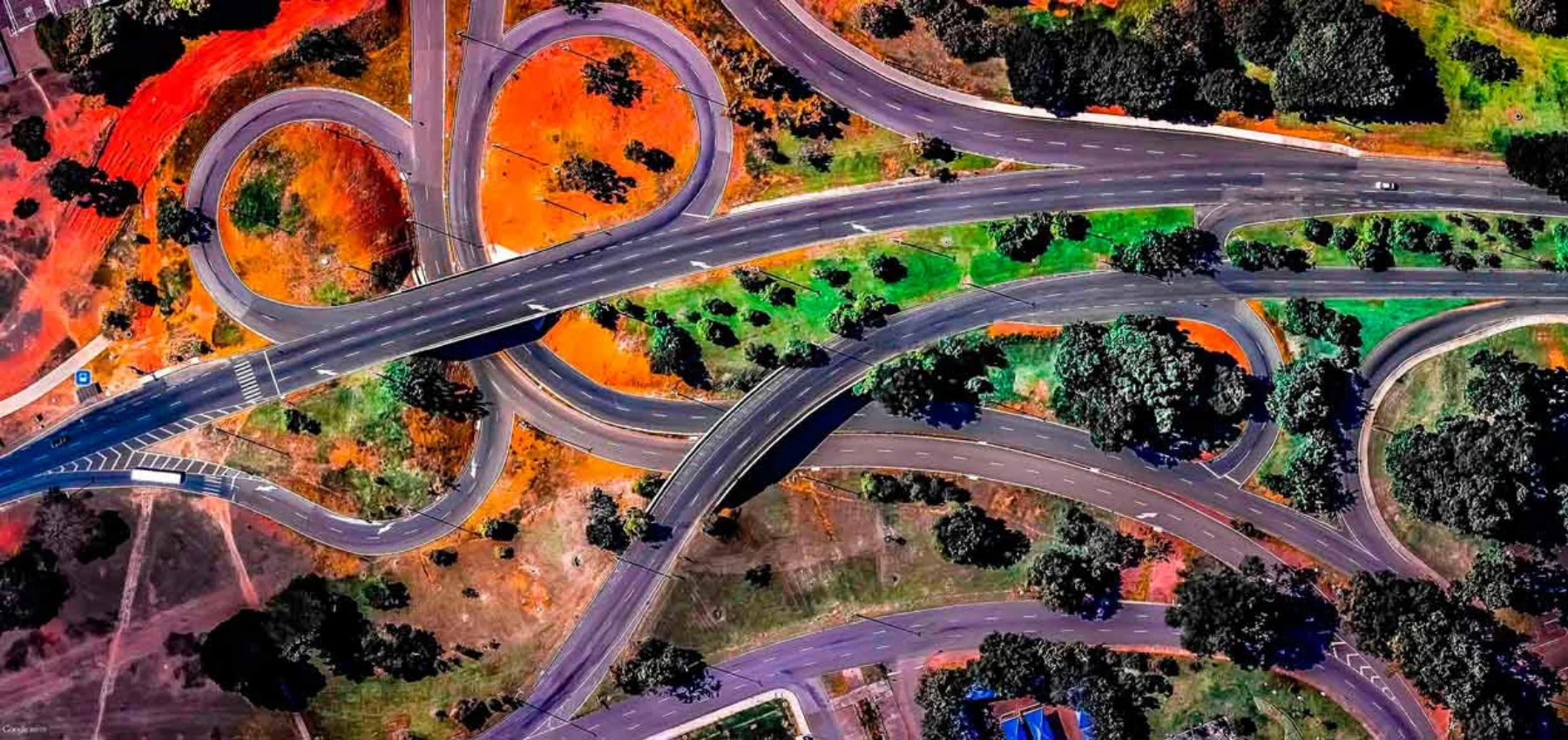Postcard from Google Earth (48°24’31.45″N, 122°38’45.52″W), 2010
Postcard from Google Earth (48°24’31.45″N, 122°38’45.52″W), 2010 is part of a series of image captures (screenshots) collected by Clement Valla entitled Postcards from Google Earth. These satellite images, discovered through the Google Earth interface, can best be described as surreal. Landscapes, roadways, bridges and buildings appear distorted and warped, melting and twisted like the strange reflections of a funhouse mirror. The floating roadways and bridges turn to ribbon and flow like liquid, hovering above and casting a shadow on the water and earth below.
Because Postcard from Google Earth (48°24’31.45″N, 122°38’45.52″W), 2010 visually simulates the ‘error on loading’ of a digital image, it is often incorrectly categorized as glitch art. With glitch art, digital or analog errors cause a skip or hiccup to occur, creating a glitch in the clarity, fidelity, and consistency of an image. However, Postcard from Google Earth (48°24’31.45″N, 122°38’45.52″W), 2010 was created when the algorithms that gather the Google Earth imagery encountered an image with severe angles and too much depth, causing an anomaly in the system, not an error or ‘glitch’. Through this incorrect representation of the earth’s surface the constraints of the algorithm are revealed, thus creating a new visual topography.
"At first, I thought they were glitches, or errors in the algorithm, but looking more closely I realized that the real situation was actually more interesting - these images are not glitches. They are the absolute logical result of the system. They are an edge condition - an anomaly within the system, a non-standard, an outlier, even, but not an error." Valla, Clement (2012, July 31) The Universal Texture, Rhizome.
Postcards from Google Earth 3D images are generated through texture mapping and occur at the intersection of two competing data inputs, the 3D model of the earths surface and 2D aerial photographs. What’s most interesting is the lack of human involvement in the creation of the artworks. These ‘happy accidents’ are made possible exclusively through the intersection of the data. In fact, human interference is necessary in order to correct the irregular image quality. Once intercepted, the unique characteristics of the original computer-generated image are lost. The disappearance of this data demonstrates the constant, ever-changing flow of ‘the net’ and the ease with which it can be manipulated –with or without direct human involvement.
"The collection concentrates on capturing Google Earth’s algorithmic mishaps in elevation. The screen caps show surreal landscapes of twisted 3D & 2D aesthetics where stringy bridges slouch across caved in canyons and highway seem to melt with gravity." Artifacting (2011, March 9) Postcards from Google Earth, Artifacting.
Valla’s work in programming, software, photography, and sculpture is greatly influenced by his background in architecture. One can easily form a direct visual connection between Postcard from Google Earth (48°24’31.45″N, 122°38’45.52″W), 2010 and The Universal Texture Recreated (46°42’3.50″N, 120°26’28.59″W), 2014. This installation utilizes a webcam to crop a portion of the 3D photographic print in order to create a new and different image, which is then re-presented back online in the original 2D format. These Google Earth snapshots offer an unexpected view of our planet and the world we live in, thus allowing us to critically question the influence of technology on our lives. The boundaries between virtual and reality have shifted. The distinction between the two has become blurred as we now move seamlessly through the virtual space into real life.
The Net Art of Jon Rafman and Alberto Rodríguez is similar in origin to Valla’s work in that all draw inspiration from Google, however Rafman and Rodríguez employ unique and intriguing source material found through Google Street Views as the foundation of their works.
Image courtesy of the artist, Jon Rafman. Installation picts (2010) http://googlestreetviews.com/installation_pics.html
Rafman utilizes extremely personal moments to address how pop-culture effects our future community. His image captures (screenshots) of accident, incidents, and awkward human interactions are often dramatic and unsettling. As a viewer you become desensitized, a passive observer in a situation that should have your intervention.
Screen shot of Alberto Rodríguez’s “100 mts” (2014) http://hyperallergic.com/127323/using-google-street-view-to-counter-mexicos-police-violence/
Rodríguez is interested in documentary-style photography, offering a glimpse into daily life in Mexico. His personal experiences of unjust police brutality are the inspiration of this artwork. He deploys inverse surveillance and in this case often captures footage of unnecessary police violence.
Image courtesy of the artist, Federico Winer. http://www.ultradistancia.com
Far more visually intoxicating is the work of Federico Winer. His work emphasizes the patterns and textures visible only from the aerial perspective of Google Earth satellite imagery; infusing the digital images with intense color in order to accentuate particular forms within the topography. In contrast to Valla’s Postcard from Google Earth (48°24’31.45″N, 122°38’45.52″W), 2010, Winer’s imagery has been manipulated, altered, and thus created through direct human involvement.
In conclusion, the world of data mapping has now turned what was a map, into a virtual photograph. However, Postcard from Google Earth (48°24’31.45″N, 122°38’45.52″W), 2010 overtly demonstrates the inner workings of Google Earth and in turn, encourages us to focus on the process not the resulted image. The software, algorithms, and the means by which the data has been collected become the most interesting, and ultimately intriguing aspects of this artwork.
Postcard from Google Earth (48°24’31.45″N, 122°38’45.52″W), 2010 was part of the following exhibitions:
2015
· Phantom Vibrations, University at Buffalo, Buffalo, NY, USA.
· Sécurité : Que Reste-t-il De Nos Espaces De Liberté?, Art Souterrain, Montreal, Canada.
2014
· Postcards from Google Earth, Thomassen Gallery, Gothenburg, Sweden.
· Placemakers, swissnex, San Francisco, CA, USA.
· Festival des Images, Vevey, Switzerland.
· Synthetisch Vernünftig, Lab for Emerging Arts and Performance (LEAP), Berlin, Germany.
· Internet Aware: Selections from Rhizome.org, Ace Hotel, NY, USA.
Additional Press:
Postcards from Google Earth Bridges - https://vimeo.com/23532969
http://www.fastcoexist.com/1681920/the-strange-art-of-the-melting-bridges-of-google-earth
http://www.bitforms.com/valla/postcard-from-google-earth-482431-45n-1223845-52
http://www.amusingplanet.com/2014/10/the-surreal-world-of-google-earth-by.html
http://www.littlepaperplanes.com/artist/595-clement-valla
http://beautifuldecay.com/2014/10/03/clement-valla-finds-uncanny-landscapes-google-earth/
http://twistedsifter.com/2013/04/when-google-earth-goes-awry-clement-valla/
http://www.huffingtonpost.com/2012/01/12/clement-vallas-mesmerizin_n_1202937.html
http://rhizome.org/editorial/2012/jul/31/universal-texture/
http://unplace.org/sites/default/files/unplace_catalogue_en.pdf
Additional Links:
http://www.archdaily.com/623778/delve-into-the-possibilities-of-perception-with-satellite-photo-art-by-ultradistancia
http://cargocollective.com/anglemagazine/NEWS
Moving Picture Company - http://www.wired.com/2014/02/color-project-turns-satellite-maps-modern-art/








